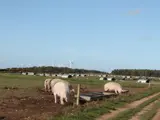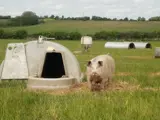Outdoor Pigs
Sustaining grass cover on outdoor pig units is challenging, but using pig-specific mixtures with a high inclusion of certain creeping grass species can promote root establishment, sward recovery and soil nutrient retention in free-range pig settings.
With good establishment and careful management, these leys can be maintained throughout pig production and help to reduce erosion and improve the water holding capacity of light soils. Studies also show grass cover can bring valuable benefits to pig welfare and productivity.
Rooted and robust
Grass mixtures that optimise cover, protect soil and benefit outdoor pig production.
by Jane Jordan, pig specialist, member of BGAJ. ©2023
Achieving and maintaining decent ground cover on outdoor pig sites is difficult, but it can be done if producers choose to use more resilient grass mixtures and manage their paddocks in ways that allow areas of land a rest period while still in production.
Protecting ground water and preventing soil erosion are principal motivators for nurturing green cover on outdoor pig sites, and businesses that have implemented a grassland management plan for their production sites do find that ‘growing green stuff under trotters’ can also improve pig welfare and subsequent crop performance.
Drilling stubbles immediately after harvest, then allowing a good establishment period (at least 3 months) before the pigs move in offers measurable benefits. It creates a more resilient sward, with a root structure that is more capable of maintaining and improving soil structure, holding nutrients and reducing erosion than stubble/bare ground.
In East Anglia, a number of pig businesses are now committed to longer-term rotational contracts that enables them to seed and grow the acreage designated for pigs for at least 3-4 months before the herd moves in. Others are working with their landowners so pigs can move onto stewardship cover as this land comes back into food production.

Practical trials, proven results
In 2020 North Norfolk producer LSB Pigs embarked on a two-and-half-year grassland trial to compare the performance and environmental value of paddocks sown with a pig specific grass seed mix with those sown with a traditional legume/ryegrass mix. Supported by the Norfolk Rivers Trust, Anglia Water, AHDB and a well-known seed supplier, the project uncovered numerous benefits.
The 1500-sow weaner production business managed its pigs on land sown with two seed mixtures:
- one, a specific pig-resilient blend containing a high percentage of creeping red fescue, an intermediate perennial ryegrass, and late perennial ryegrass species at a rate of 35kg per ha
- the other a 2-year fallow-type mix, originally designed for Ecological Focus Areas (EFA), sown at 20kg per Ha. It included Italian ryegrass, vetch, Birds Foot trefoil and Red Clover.
As expected, the paddocks sown with the pig mix provided better cover. Agronomists supervising the trial noted how swards with the higher content of creeping red fescue retained green cover for longer and appeared to develop a more resilient root network - characteristics that would promote soil structure and hopefully improve nutrient and the land's water holding capacity.


